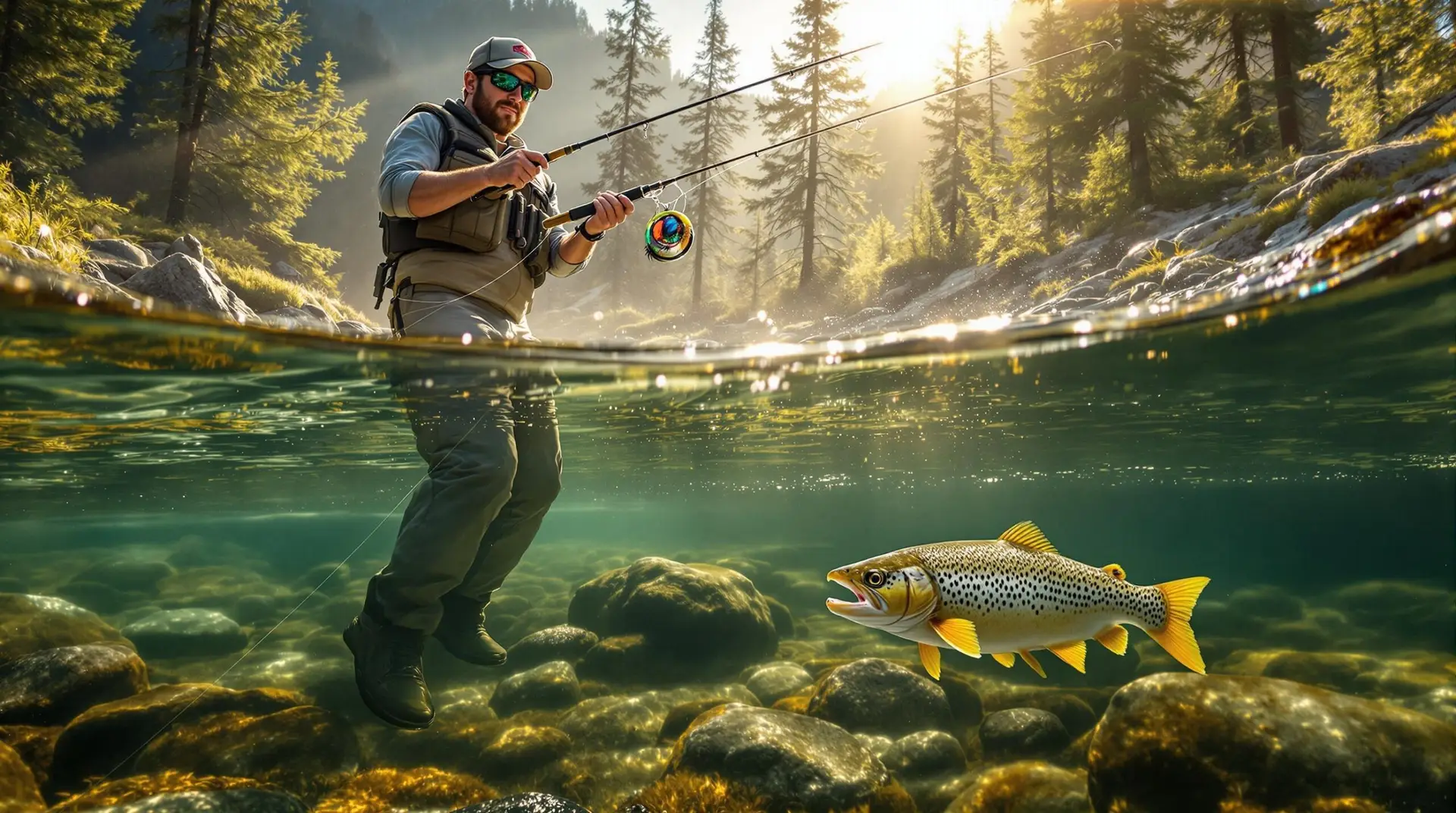Advanced Nymphing Techniques
Getting the hang of advanced euro nymphing means you’ve got to be sharp with the little details of using nymph indicators and have the eyes of a hawk to spot strikes and make those drift adjustments count.
Indicator Fishing Strategy
In this gig, indicator fishing is about using heavy weights on flies and keeping your pole high and tight, which the pros call high-sticking (Midcurrent). It ain’t just to look cool though. High-sticking keeps your flies cruising slow, deep, and free from the drag net, pulling off that smooth, tricky drift that fish just can’t say no to. It’s not just a flasher for strikes – use the indicator like a map, giving you a real-time tracker on your fly’s travel route with those surrounding bubbles showing what’s what. Fine-tuning your approach is a step closer to hauling in a catch that’s brag-worthy.
| Technique | Description |
|---|---|
| High-Sticking | Keeps flies slow, deep, and drag-free |
| Heavy Weights | Mimics the natural flow of underwater food |
| Drift Indicator | Acts like a GPS for your flies’ path |
Importance of Observation
Watching that indicator like a hawk is your secret weapon for upping your nymph game (Midcurrent). Just like spying a bobber twitch in regular fishing, any subtle shift in the indicator signals you to strike. These movements tell you loads about how your flies are rolling under the surface and their impact on the fish vibe.
Mixing up your indicators to catch those sneaky fish comes down to mastering both drift and strike checks. A splash of color on the indicators can really stand out, even when the sun’s playing hide and seek. And always be mindful of where they’re sitting next to the leader – the goal is to keep it natural and drag-free.
| Observation Aspect | Importance |
|---|---|
| Indicator Behavior | Alerts you when to get in action |
| Positioning Relative to Bubbles | Sharpens your drift tracking |
| Dual-Color Indicators | Visibility boost for tricky lighting |
These nymphing tricks are like a masterclass in handling Nymph Drift Mechanics and Technical Nymph Fishing. Dialing these skills in will definitely add some firepower to your euro nymphing. Got the hunger for more insider knowledge? Slide over to our deep dives on Contact Nymphing Technique and Multiple Nymph Rigs for advanced insights.
Indicator Selection Tips
Getting the right indicator is like picking the perfect dance partner in Euro nymphing. These little gadgets do double duty: they let you know when a fish is into your fly and clue you in on how your drift is going. Let’s break down how to keep an eye on what these indicators are up to and why playing with colors can make your fishing day a hit.
Indicator Behavior Observation
In the world of nymphing, indicators are your eyes under the water. They float atop the fishing line, screaming, “Hey, there’s action going on down here!” Watching these colorful bobbers is your ticket to catching subtle fish strikes and nailing those hook sets.
Indicators shimmy along the water’s surface, following the nymph fly dance below. The smart angler’s job? Tune into their every twitch:
- Movement Patterns: If your indicator suddenly hits the brakes or shoots down, it’s fish time.
- Indicator Stops: A halt might mean a fish is dining on your fly or you’ve hit a snag.
- Behavior Shifts: Tiny twitches or light dips could mean a fish is having a nibble party on your nymph.
Don’t just depend on these gadgets to tell you when to strike — let them guide you on how the nymph is drifting, too.
| Indicator Behavior | Possible Cause |
|---|---|
| Stops Moving | Fish strike or snagged nymph |
| Pulsing/Twitching | Fish nibbling on the nymph |
| Slowing Down | Current change or dragging nymph |
Want more juicy details about nymph drift and indicator magic? Check out nymph drift mechanics.
Using Different Indicator Colors
Mixing up indicator colors can make all the difference in seeing what’s happening on the water. Bright shades pop against any water and lighting combo, making even sneaky fish bites noticeable.
- Bright Colors: Use neon green, orange, or chartreuse in clear water and sunny spots.
- Dark Colors: Black or dark red work wonders when the light dims or water turns muddy.
- Combinations: Some folks mix it up with black and white combos to adapt to changes.
Every color brings something unique to the table, ensuring you catch more bites more often.
| Water/Light Condition | Recommended Indicator Color |
|---|---|
| Clear Water, Bright Light | Neon green, orange, chartreuse |
| Murky Water or Low Light | Black, dark red |
| Variable Conditions | Dual-color (e.g., black/white) |
Changing colors based on conditions helps you see strikes better. Play around with different shades to find out what clicks for your unique fishing spot. For more info on nymph pattern tricks and tactics, dive into our nymph pattern selection resources.
Master these tips and tricks to up your nymph fishing game, catch more fish, and become a star with the perfect indicator for your fishing escapade!
Nymph Patterns for Success
Picking the right nymph is key to making the most out of euro nymphing techniques. We’re gonna chat about why bigger nymphs rock and how floating dry flies can up your fishing game.
Why Bigger Nymphs Matter
Using bigger nymphs can really work wonders, especially when spring first shows its face. Trout around this time aren’t picky—they see a big nymph, they go for it. Some folks over at Midcurrent swear by it, saying these heftier nymphs often snag more bites than the tinier ones during early spring, all because trout are chompin’ down hard.
| Season | Best Nymph Size | Success Rate (%) |
|---|---|---|
| Early Spring | Bigger Nymphs | 70 |
| Late Spring | Medium Nymphs | 60 |
| Summer | Smaller Nymphs | 50 |
| Fall | Bigger Nymphs | 65 |
Aside from getting trout’s attention, big nymphs also sink faster and show up better, making them a good choice for those deeper or quicker currents. If you wanna learn more about how to pick the right nymph, peep our nymph pattern selection guide.
Floating Dry Flies: The Secret Weapon
Putting a bouncy dry fly in the mix, along with a second nymph, can boost your odds immensely. It’s a dual attack: you get to try out different nymphs while also seeing if any trout take the dry fly. Over at Trout Fly Fishing, they say this two-fly trick is golden, upping your nymph game and adding a chance for a surprise hit on the dry fly.
| Combo | Detection Rate (%) | Dry Fly Hit Chance (%) |
|---|---|---|
| Just Nymph | 40 | – |
| Nymph + Dry Fly | 60 | 20 |
Floating dries also keep the nymph away from the riverbed and let you control its depth, which means you can serve up a fly better suited to what trout want. Wanna finesse your dry fly use? Check out our advanced euro nymphing guide.
Learning to juggle bigger nymphs with floating dry flies can up your fishing game significantly. Play around with these patterns, tweak them based on what’s happening around you, and you’ll find your sweet spot soon enough. For more tips on setting up your gear just right, have a look at our multiple nymph rigs guide.
Techniques Comparison
Choosing your nymph technique isn’t just about picking up the rod and casting. Here, we size up Tight Line Nymphing and Indicator Nymphing, weighing their perks and quirks.
Tight Line Nymphing Benefits
Tight Line Nymphing hooks many seasoned anglers with its unique edge. It offers the power of control over your flies and sharpens your strike alertness like a fish-whisperer.
| Benefit | Description |
|---|---|
| Ultimate Control | Pinpoint fly placement and movement mastery. |
| Strike Detection | Feel even the faintest nibble. |
| Less Adjustment Needed | Keeps it straightforward; not much tweaking needed. |
| Fewer Tangles | Keeps you clear of the dreaded line mess. |
But, ain’t everything peachy. Wrangling too much line contact, the breeze bullying you around, and playing the distance game can be a bit of a pain (Troutbitten). For more tricks of the trade, check out our technical nymph fishing guide.
Advantages of Indicator Nymphing
Indicator Nymphing is your buddy when you want smoother sailings, casting long distances, and taming the wind’s might.
| Advantage | Description |
|---|---|
| Smooth Drifts | Keeps it natural as you glide along. |
| Distance Casting | Stretch those lines farther than you’d think. |
| Wind Resistance | Manages windy escapades better. |
| Versatile Drift Angles | Mix it up with different drift styles. |
| Depth Suspension | Keeps your flies hanging out at just the right depth. |
| Less Wading | No need for soggy pants and knee-highs. |
Yet, not all shines in the indicator domain. Less command over your flies, weaker nibble detection, and the common urge to tweak settings can be bothersome (Troutbitten).
Level up your strategy with the perfect toys; our tips on the best nymph indicators might just come in handy.
Both Tight Line and Indicator Nymphing roll out their own brand of goodies and hiccups. By getting to grips with what each brings to the river, seasoned anglers can tailor their approach, armed for any waterway out there. For adding some flair to your tactics, swing by our piece on nymph pattern selection.

